NADIS Cattle Report and Forecast – June 2007
ADULT CATTLE
There was a pronounced dip in veterinary activity during the warm and dry April, so this month’s figures are a chance to see whether the drops were simply problems being left over until May or were the start of a trend. Overall the figures show that in most cases the numbers of reports in May was similar to that in April with no further large drops in report numbers. Furthermore there were only a few diseases where there was a marked increase which reversed the April drop which suggests that the low April figures were representative of much of what was happening on farm.
Metabolic disease
The number of displaced abomasums (DAs) reported in May fell further from the low April figure and were for the second month below the long term average (1997 -2005). Nevertheless the number of reports is still higher than they were in any May from 1997 to 2001. We seem to have reached a plateau. Like last year the number of DA cases peaked in March rather than April and May as has been the trend in past years. We would be very interested to hear any ideas about what drives the seasonality of DAs. Is it the weather or is there an association with turn out. Nevertheless despite the large drop this month, high DA levels seem here to stay as the figures seen this year are still higher than those seen in any year other than 2004 – 2006.
Neil Frame in Cumbria commented that the number of LDA’s seen by his practice was down sharply on previous years but he was not sure why. He also thought that the reason the level of farm work was lower than last year was probably because due to the good weather the cows had been turned out earlier this year so that his practice was not seeing the diseases associated with housing.
Figure 1: Number of monthly reports of DA in 2007 and 2006 compared to mean of 1997-2005.
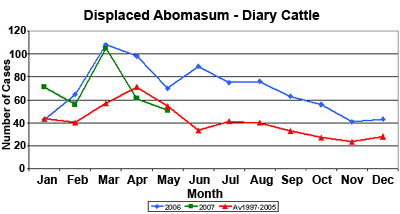
After a 200% rise in March and an almost equivalent drop in April, acetonaemia reports fell slightly in May. So far this year the number of reports has been well down on expected except in March. Ideas as to why this is the case would be welcomed
The number of milk fever reports rose slightly in May but as they have since January remained well below the long term average. So far this year the number of milk fever reports has been lower than any previous year except for 2001. As the months of April and May were the bottom of the drop in milk fever reports during 2001, it is highly likely that in a couple of months this year will hold the record for fewest milk fever cases. Thoughts as to why this is the case would be gratefully received. Milk fever remains a significant problem on many farms so its prevention is likely to remain a major veterinary role. If vets are not involved in milk fever treatment and control then both economics and animal health will be suffering.
Figure 2: Comparison between long term average of milk fever reports and reports for 2001 and 2007
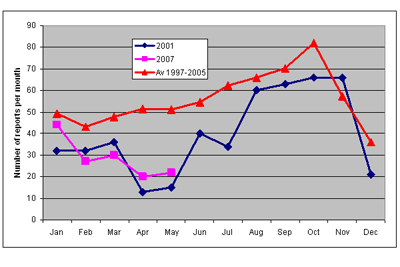
The prediction that hypomagnesaemia cases would be low in May was confirmed with no real increase in the number of reports in May compared to April. Although June is a high risk month for hypomagnesaemia it is unlikely that there will be a rise in cases this month which will mean that spring 2007 has seen the fewest ever reported cases of hypomagnesaemia.
Figure 3: Comparison of the number of reports of hypomagnesaemia between January and May for each year since 1997
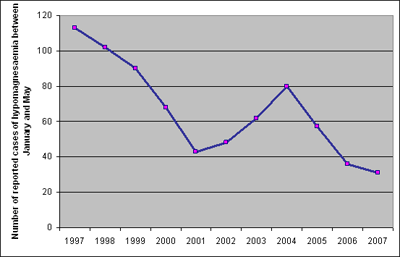
Mastitis
No summer mastitis cases have been reported so far this year. June is usually the first month when severe problems occur but it’s still far behind July to September. It will be interesting to see whether global warming affects the seasonality of summer mastitis.
Fertility
The number of non-detected oestrus cases increased dramatically in May, back to the long-term average as seen in March. Clearly for NDO, April was an aberrant month. Any suggestions as to why would be most gratefully accepted!
The number of uterine torsions also increased in May. This condition like DA has been linked to large cows with large volumes of abdominal space, and like DA has been seen at higher levels recently. However the reports so far this year suggest that the number of cases has fallen to levels below those seen in recent years, and the prediction is that this year will see the fewest cases since 2000.
Figure 4: Change in yearly reports of uterine torsion (with predicted number for 2007)
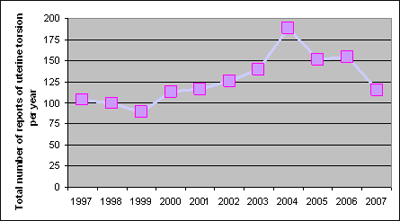
Lameness
Overall lameness cases dropped by almost 50% in April, with dramatic falls in all four of the major diseases. The largest fall was for digital dermatitis with only four reports in April against a long term average of over 40! These reversed in May with all four of the main diseases increasing back to more normal levels. However all are still below the long term average showing that lameness reports by NADIS vets are still on a long term decline. We urgently need to identify whether this trend is down to less involvement on-farm or less lameness. One is good news the other not so good! Hopefully this will be one of the questions that the new Defra initiatives will be able to answer.
A North Scotland vet reported that one of his farms has converted from tie stalls to cubicles and experienced an increase in sole ulcers and white line disease. This has been a major problem in Scandinavia where tie stalls are being phased out. A good demonstration of where solving one welfare problem can cause another!
In April, an unusual outbreak of lameness in a herd at turn out was reported in Powys. On being released from winter housing 2 cows broke their cannon bones while running round the yard and 8-10 animals appeared stiff. Further tests showed high concentrations of lead in the kidney of one of the cows with a broken leg (suggestive of interference of calcium metabolism by lead). However he also reported later in the month that cows that had stiffness on turn out into the sunshine had got steadily better even though some appeared almost crippled on release and none had received any treatment. The vet also reported that the swellings around the growth plates on the canon bones reduced after turnout. This strongly supports his diagnosis of vitamin D deficiency. Has anyone seen anything similar?
A Dumfriesshire vet reported an outbreak of superfoul in beef cattle with 15 animals affected. This disease, which is probably a combination of foul-in-the-foot and digital dermatitis (although that is far more proven), seems to have become rarer in recent years. This is the first report we have had in beef cattle. Has this been seen on other farms? Is it still present on dairy farms?
Other diseases
Bovine iritis (silage eye) cases usually peak in Feb-April as the final silage of winter is fed out. However this year’s figures have been much lower than normal and lower than 2006 which was already very low and May continued that trend. These low figures suggest that the quality of baleage has probably been better this year than average, although it cannot be discounted that the reduction in cases is due to vets being less likely to be called out to see such cases. This highlights that with a bit of additional support the NADIS data would provide even more valuable information on an important and painful disease (it is the most commonly reported disease caused by Listeria in cattle).
Figure 5: Reports of bovine iritis by month showing that the peak of cases has been much lower in 2006/7 than average.
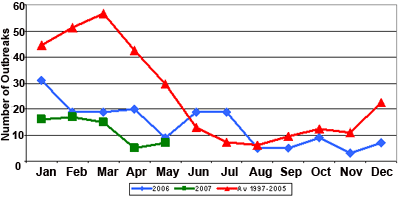
CALVES
Despite rising in May compared to April both calf scour and enzootic pneumonia remained at levels well below the long term average, with both being the lowest ever recorded. Again it’s unclear whether these reductions are due to better disease control or less use of vets. Additional support to collect more data, such as that from sentinel farms, would greatly enhance the value of the NADIS data. We would be very interested to hear all opinions on how much of the low level of calf disease is due to it being actually less common or less commonly seen by vets.
Copyright © NADIS 2007 www.nadis.org.uk
